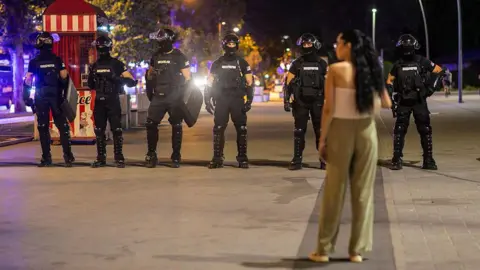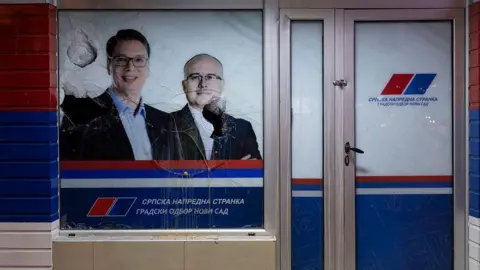BBC Balkans correspondent
 Getty Images
Getty ImagesAs Serbia’s anti-corruption protests enter their ninth month, they show no sign of abating – and are instead changing in their leadership, composition and tactics.
At the climax of last weekend’s 140,000-strong protest in Belgrade’s Slavija Square the students who led the protests since November declared that they would no longer spearhead the rallies.
They had set a deadline of Saturday for the government to call for fresh elections.
When that was not met, they invited other groups to take on the protest mantle – and called for a campaign of “civil disobedience” from anyone opposed to the leadership of President Aleksandar Vucic and his long-governing Progressive Party (SNS).
Since then roadblocks have been popping up in cities across Serbia this week and people have been deploying dustbins, chairs and other improvised barriers to block junctions in major cities including Belgrade, Novi Sad and Nis. Local residents’ associations – known as “citizens’ assemblies” – have been heavily involved.
As soon as the police dismantle one blockade, another one pops up somewhere else.
Police crackdown triggers backlash
In recent days there have been dozens of arrests – along with complaints of excessive police force. A number of students were treated in hospital – one with a broken collarbone – after Gendarmerie members entered Belgrade University’s Law Faculty on Wednesday.
Officers also arrested high school students, triggering a protest by parents in front of a central Belgrade police station until their children were released.
A striking range of voices have condemned the police conduct. Complaints by the journalists’ association and the opposition Centre Party were matched by statements from the Bar Association and even Serbian Orthodox Church Archbishop Grigorije Duric. The EU, for its part, decried the “acts of hatred and violence” and called for calm.
Meanwhile, in Belgrade, the pop-up roadblocks continue – and so does the ensuing travel chaos for commuters.
One resident, while ruefully noting that she had to walk 5km (3 miles) to and from work, described the mood as more like a series of street parties than a protest.
But many observers doubt whether this approach will be any more effective than the months of rallies, faculty blockades and half-hearted general strikes.
The 2024 Novi Sad railway disaster
The protest movement started with a relatively simple purpose: to ensure accountability for last November’s disaster at Novi Sad railway station, when a concrete canopy at the recently renovated facility in Serbia’s second city collapsed, killing 16 people who were standing beneath it.
The outpouring of grief was instant – and the outrage swiftly followed.
Much of it has been directed at President Vucic.
A large section of Serbians have long been uneasy with his “strongman” style of leadership, since he came to power in 2012. But others have accepted his party’s firm grip on state institutions and much of the media as a trade-off for strong economic growth and improvements in infrastructure.
The station disaster shattered that tacit agreement.
“We are all under the canopy” was one slogan frequently seen on banners in the early days of the protests. Others included “blood on your hands” and “corruption kills”.
University students took leadership of the movement, demanding full transparency about the railway station project and the prosecution of those responsible for the disaster.
Months of protests eventually forced the resignation of Milos Vucevic as prime minister. But he was simply replaced by another Vucic appointee, Djuro Macut – and the protest movement has otherwise achieved little in terms of concrete results.
 Getty Images
Getty ImagesNo end in sight for protest movement
Still, the protests have now brought hundreds of thousands out into the streets and are galvanising large sections of society.
One opposition leader, Srdjan Milivojevic of the centre-left Democratic Party, compared the moment to the early 2000s, when the student-led protests against the notorious President Slobodan Milosevic “became a people’s movement”.
Then, a coalition of interest groups stood firm against Milosevic’s attempts to manipulate the result of the September 2000 presidential election. Mass protests forced the president’s resignation the following month and ushered in democracy in Serbia for the first time.
But despite efforts to invoke the “spirit of 5 October”, the current situation is different. President Vucic and his party remain in a relatively comfortable position, with polls indicating that the SNS remains the most popular party.
In the aftermath of the last, big student-led rally, Mr Vucic declared that “Serbia won” in the face of an attempt to “overthrow the state”.
The people blocking the roads in Serbia’s cities view it differently. They are asking for change through the ballot box – even if it is far from clear who would run against the SNS. And the president insists there will be no elections before December next year.
So now it is perhaps a question of which side blinks first. And with temperatures already pushing towards 40C, it could be a simmering summer in more ways than one.
